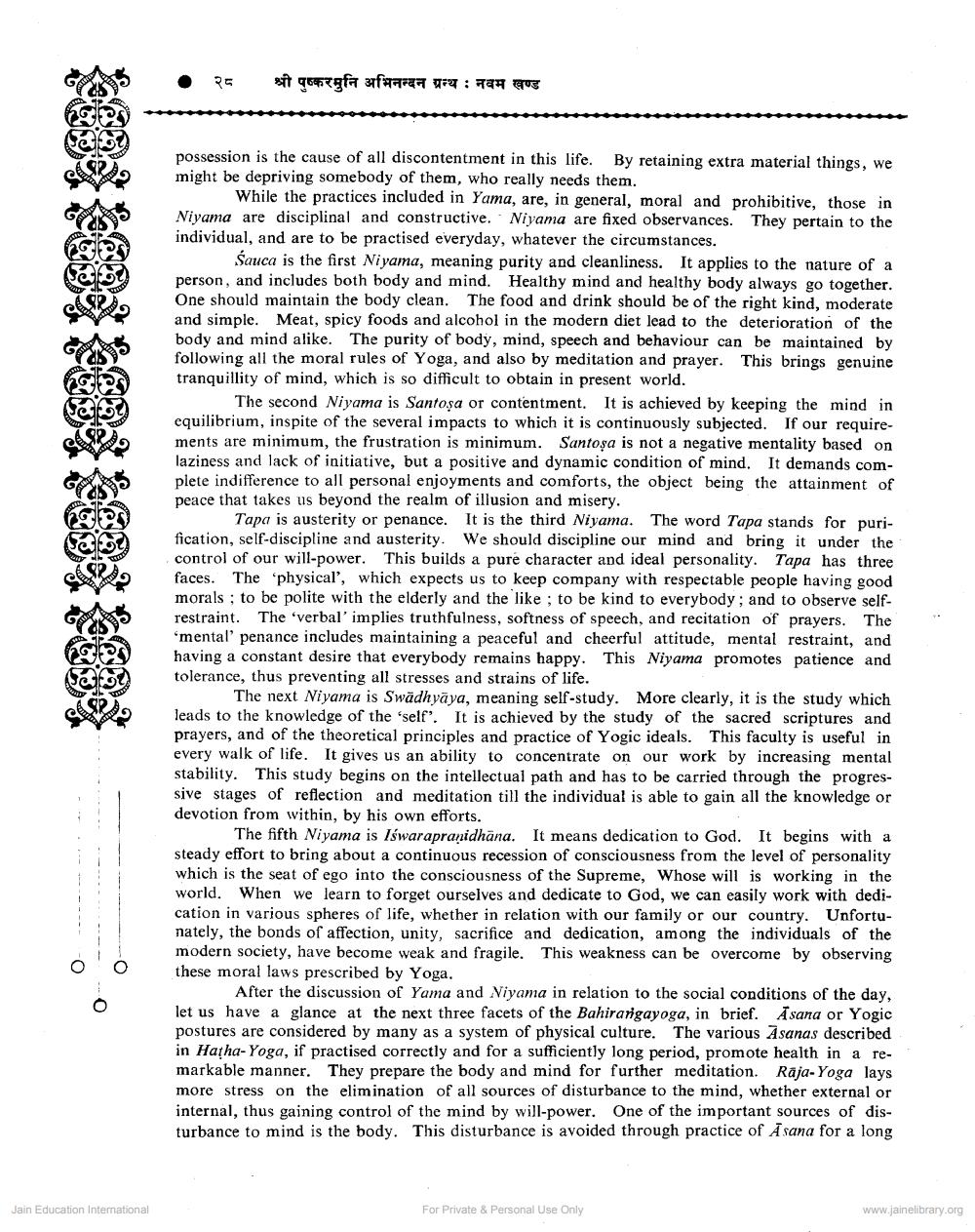________________
२८
श्री पुष्करमुनि अभिनन्दन ग्रन्थ : नवम खण्ड
possession is the cause of all discontentment in this life. By retaining extra material things, we might be depriving somebody of them, who really needs them.
While the practices included in Yama, are, in general, moral and prohibitive, those in Niyama are disciplinal and constructive. Niyama are fixed observances. They pertain to the individual, and are to be practised everyday, whatever the circumstances.
Sauca is the first Niyama, meaning purity and cleanliness. It applies to the nature of a person, and includes both body and mind. Healthy mind and healthy body always go together. One should maintain the body clean. The food and drink should be of the right kind, moderate and simple. Meat, spicy foods and alcohol in the modern diet lead to the deterioration of the body and mind alike. The purity of body, mind, speech and behaviour can be maintained by following all the moral rules of Yoga, and also by meditation and prayer. This brings genuine tranquillity of mind, which is so difficult to obtain in present world.
The second Niyama is Santosa or contentment. It is achieved by keeping the mind in equilibrium, inspite of the several impacts to which it is continuously subjected. If our requirements are minimum, the frustration is minimum. Santoșa is not a negative mentality based on laziness and lack of initiative, but a positive and dynamic condition of mind. It demands complete indifference to all personal enjoyments and comforts, the object being the attainment of peace that takes us beyond the realm of illusion and misery.
Tapa is austerity or penance. It is the third Niyama. The word Tapa stands for purification, self-discipline and austerity. We should discipline our mind and bring it under the control of our will-power. This builds a pure character and ideal personality. Tapa has three faces. The physical', which expects us to keep company with respectable people having good morals; to be polite with the elderly and the like ; to be kind to everybody, and to observe selfrestraint. The 'verbal' implies truthfulness, softness of speech, and recitation of prayers. The mental' penance includes maintaining a peaceful and cheerful attitude, mental restraint, and having a constant desire that everybody remains happy. This Niyama promotes patience and tolerance, thus preventing all stresses and strains of life.
The next Niyama is Swädhyāya, meaning self-study. More clearly, it is the study which leads to the knowledge of the "self". It is achieved by the study of the sacred scriptures and prayers, and of the theoretical principles and practice of Yogic ideals. This faculty is useful in every walk of life. It gives us an ability to concentrate on our work by increasing mental stability. This study begins on the intellectual path and has to be carried through the progressive stages of reflection and meditation till the individual is able to gain all the knowledge or devotion from within, by his own efforts.
The fifth Niyama is lŚwarapranidhāna. It means dedication to God. It begins with a steady effort to bring about a continuous recession of consciousness from the level of personality which is the seat of ego into the consciousness of the Supreme, Whose will is working in the world. When we learn to forget ourselves and dedicate to God, we can easily work with dedication in various spheres of life, whether in relation with our family or our country. Unfortunately, the bonds of affection, unity, sacrifice and dedication, among the individuals of the modern society, have become weak and fragile. This weakness can be overcome by observing these moral laws prescribed by Yoga,
After the discussion of Yama and Niyama in relation to the social conditions of the day, let us have a glance at the next three facets of the Bahirarigayoga, in brief. Asana or Yogic postures are considered by many as a system of physical culture. The various Asanas described in Hatha-Yoga, if practised correctly and for a sufficiently long period, promote health in a remarkable manner. They prepare the body and mind for further meditation. Raja-Yoga lays more stress on the elimination of all sources of disturbance to the mind, whether external or internal, thus gaining control of the mind by will-power. One of the important sources of disturbance to mind is the body. This disturbance is avoided through practice of A sana for a long
o'o
Jain Education International
For Private & Personal Use Only
www.jainelibrary.org




